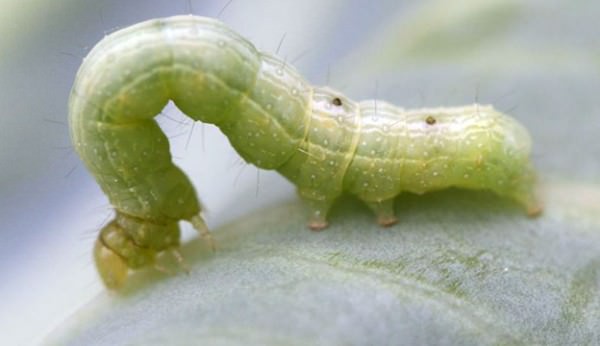
The brassica family—kale, collards, broccoli, cabbage and mustard, to name a few—can be a fun group of crops to grow, but we’re definitely not the only ones who love them. From harlequin bugs that devour young plants to one of the many small worms that eat new growth, brassicas have no shortage of fans. One of the more destructive brassica pests is the cabbage looper (Trichoplusia ni), and with some ingenuity, you can keep them out of the garden without having to resort to BtK or other insecticides.
Like the imported cabbageworm, the cabbage looper is small and green. The larvae of the nocturnal brown moth, it gets its name from the way it moves, arching its back like an inchworm, creating a loop of sorts, and pulling itself forward.
Although green like the cabbageworm, the looper is slightly larger—about 1½ to 2 inches long—with white stripes down its back. Moving relatively quickly, the looper feeds on the underside of brassica leaves, taking large bites as it goes. These holes are the first sign that cabbage loopers are in your garden, and soon, your cole crops can quickly turn to skeletonized plants.
Take preventative action against cabbage loopers to save your plants and yourself a lot of trouble.
1. Row Cover
Because the cabbage looper is a moth larva, preventing that moth from ever laying eggs on your brassicas is the best way to avoid cabbage loopers. Floating row cover, which can be purchased from most organic growing-supply stores, keeps the these moths and others from laying eggs on young plants. After transplanting any brassicas, place the floating row cover gently over the plants and weigh it down, either by burying the edge in soil or laying rocks along the sides. It can be annoying to have to remove the row cover to cultivate and weed, but a lot less annoying than losing plants to hungry worms.
- Advantage: keeps the moths from laying eggs on your brassicas
- Disadvantage: removing and replacing row cover after every cultivation
2. Companion Plants
Even if cabbage loopers aren’t a problem for you, pollen- and nectar-producing plants will enhance your garden health and aesthetics. Dill, parsley, yarrow, catnip and other flowering herbs do a great job of attracting pollinators and tiny predators, such as parasitic wasps, that lay their eggs on garden pests like cabbage loopers and hornworms. The wasp larvae hatch out of what looks like tiny white spikes on the worms and feed on the pest, thus destroying it. Other predators that feed on looper eggs and young larvae will also flock to the nectar and pollen plants. Set aside some ground or a few small pots specifically for this purpose. Plant a lot of these attractant plants, and sow them in succession so they’re always flowering when you need protection.
- Advantage: attracts parasitic wasps and other pest predators
- Disadvantage: takes up garden space
3. Manual Worm Removal
Although it can be tedious, removing worms by hand is an underrated remedy to a cabbage-looper problem. If you cull cabbage loopers a couple times a week, you can eliminate them without much difficulty or loss.
Start in the early spring by scraping any eggs you see off the bottom of young plants. If dealing with mature larvae, simply pick the worms by hand from the underside of leaves and deposit into soapy water. The looper, as well as the imported cabbageworm, often seeks refuge in the stalks of broccoli, so look for them there. If you see a looper with several white spikes, do not kill it. Those are the eggs of the parasitic wasp and you want them to hatch out.
- Advantage: effective way to remove and remedy cabbage loopers
- Disadvantage: tedious and time-consuming
4. Worm-Resistant Plants
We all have our favorite cabbage, broccoli and kale varieties, but if cabbage loopers tend to be a problem in your small garden, consider experimenting with seeds bred to be more resistant to the pest. Consult your seed catalogs for next year’s options.
- Advantage: no extra work for you
- Disadvantage: might not be the variety you like to eat or that grows well in your climate
5. Garden Clean-Up
Once the cabbage looper has survived for a few weeks, it pupates. You can find the cocoons underneath brassica leaves, where the looper moths for the following year will emerge. Till in or bury all brassica leaves before the next spring.
- Advantage: minimizes future cabbage-looper populations
- Disadvantage: time-sensitive chore




